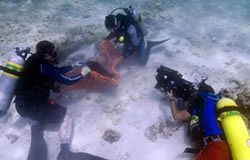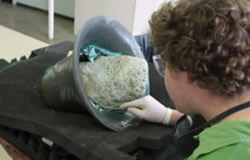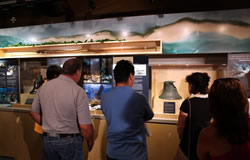Artifact Conservation - New Life for Old Artifacts

Stephani Gordon films Tane Casserley and Hans Van Tilburg recovering the Parker bell at Kure Atoll. Credit: NOAA/Gleason.
Maritime archaeologists do not remove artifacts from a wreck site until the entire site has been properly surveyed and documented. Even still, recovery of artifacts is rare, and costly when done properly. Artifacts may be recovered if there is a chance that it may be subject to looting, or damage. Also, artifact recovery may be important for further research, education and outreach, and identification of a site. Shipwreck sites in the Northwestern Hawaiian Islands are remote and few people will ever get to visit them, creating exhibits such as the "Lost on a Reef" exhibit at Mokupāpapa Discovery Center in Hilo help visitors to get a chance to understand these sites and connect with pieces of this history. The artifacts are a window into the broader story of maritime heritage in the Monument.
Proper recovery and conservation of submerged artifacts is critical. All artifacts recovered in the Northwestern Hawaiian Islands have been sent to the Heritage Resources Conservation Laboratory at the California State University, Chico. The lab is directed by Dr. Georgia Fox. Experts with a great deal of experience conserving artifacts submerged for hundreds of years in seawater are able to reverse some of the processes of degradation that occur on the seafloor. This process is costly and takes months, even years. The artifacts are returned to Monument staff for research and display for the public.


